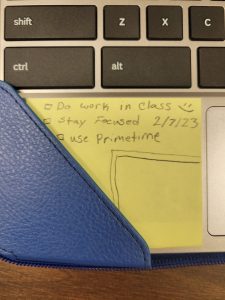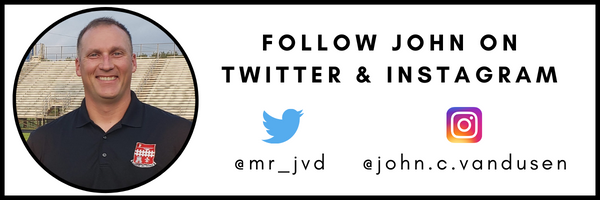TL;DR:
- A goal without a plan is simply a wish. You can wish to do better or you can plan to do better.
- Start with the end state. Focus on developing a specific plan and work on the process to achieve your goals. Consider resources needed too.
- Plan the work that is needed to be done. Measure progress every day.
- Concentrate on the process and it becomes the goal.
The Problem: “I wish…”
As the first semester came to a close, I sat down with a young lady who was frustrated about her grades. For a nine-week quarter, my U.S. history class usually has between 8-12 assignments based on what projects are associated with the material. This young lady missed four assignments and had done poorly on the assignments she turned in.
Almost in tears, she said, “I wish I could do better but I just can’t!”
I sat down next to her and pointed to her first quarter grades where she had an A- and said, “You can do better! You have done better!”
Slumped in her chair, I asked if she had ever heard of a growth mindset. She said that she hadn’t, and I asked if she would be willing to hear about it because I was sure that it would help her get better grades. She said “no,” so I went back to my desk.
As I reached my desk she came up and said, “Ok. Fine. What’s a growth mindset?”
I gave her a basic definition and explained that if she really wanted to do better, she would need a plan. I said, “A goal without a plan is simply a wish. You can wish to do better or you can plan to do better.”
The classic middle school eye-roll and hair toss was followed by, “I don’t know how to make a plan, so I guess I don’t know what to do.”
Teacher mode: ENGAGE!
A goal without a plan is simply a wish. You can wish to do better or you can plan to do better. Click To TweetSetting a Goal: Process Over End State
As I walked her through a plan to improve her grades, we took it one step at a time, answered some basic questions, and came up with some simple ideas to turn her wish into a goal. Her entire plan consists of three items on a sticky note with a date that is taped to the inside of her computer case. Your plans may be more intensive, but the same process can help you improve at anything from a personal best in the gym, reading more books, or your classroom instruction.
What does the end state look like and what process do we need to get there?
This is a big-picture item. For my young student, the end state was earning a B+ by the end of the third quarter. She had earned an A- during the first quarter, but to her, shooting for that goal was “too big” after such a lapse in quarter two. Some like to use “SMART” goals (specific, measurable, achievable, relevant, timely), while others like to concentrate on the process. I am a process-oriented person, so I try to look at what can we do every day that will get us to the goal we want.
 In order to earn a B+, what has to be done? Her simple answer was this: “Turn in my work.”
In order to earn a B+, what has to be done? Her simple answer was this: “Turn in my work.”
I said, “GREAT! Now how are you going to do that?”
She came up with two items to make sure she can turn in her work. The first was to use her class time to complete her work, and the second was to use primetime (our version of homeroom) to catch up on any missing assignments.
What resources do you need to continue the process every day?
Maybe you have everything you need, maybe you don’t. It’s important to identify where the resource gaps are so that you can fill them. In the case of my young student, she needed her computer to check grades and her class materials for each class. Her computer isn’t an issue. She remembers to bring it almost every day. On the other hand, bringing a pencil to class is a struggle!
After a short brainstorming session, she decided that the best place to keep a pencil was in her computer case. Sometimes the simplest plan is so obvious. It makes us laugh out loud when we finally figure it out.
The ratio of 4 to 1 vs. 1 to 4.
To ensure she brings the materials she needs to class, we did a simple change in her passing time schedule. She is very social and likes to use those five minutes in-between classes to catch up with her friends. The problem was that she would spend four minutes talking with her friends and one minute frantically trying to grasp what she needed for class. Often times this left her in class without a book, or the wrong one, half-finished work left in her locker, and…shoot…where’s my pencil?!
The simple change was to bring her materials to class in the first minute (if it takes two, that’s okay) and to spend the last few minutes of her passing time talking with her friends. After the third day of this switch, she is much better about having her materials and is still able to catch up with her friends. Sometimes the simplest plan is so obvious that we struggle to see it for ourselves.
[scroll down to keep reading]Moving Forward: Planning Your Work and Working Your Plan
How will you know you are moving in the right direction?
The simple answer is to measure something. But what and how often? If you are trying to measure against the end state, then it may seem too big, too far away, and become discouraging instead of motivating. A better way is to measure against the process you implemented and measure it every day. In the case of my middle schooler, the two measuring sticks she has are:
- Did I use class time wisely today?
- Did I use primetime to catch up on missing work?
Somedays the answer to both of those questions is yes, while other days they are both no, or a mix between the two. However, each day grants her a new chance to be successful. Another technique, which she is not ready for yet, but may be in the future, is to keep track of the answers with a tally mark. It’s a simple but effective way to see if your plan is working. Do you have more “yes” days than “no” days?
In lieu of having her keep track on a daily basis, she wrote a date on her sticky note when she will check in with me and we will see how her plan is going. At that check-in, she may be ready to keep track of her progress herself. If so, that will be the next step in attaining her goal.
The Process Becomes the Goal
The wonderful thing about concentrating on the process instead of the goal is that you can work on the process every day, and the goal takes care of itself. Talking with my student, I asked her what would she do once the third quarter came to an end. She said, “I don’t know…what do you mean?”
“Once the third quarter is over. If you get a B-, a B+, or an A, what then?”
With a very confused look on her face and a nervous giggle, she said, “I don’t know! Keep going I guess?!” Exactly!
By concentrating on the process instead of the end state, she will easily be able to adjust her everyday habits so that she can achieve her goal. Not only that, but her goal can be adjusted without making massive changes. Simple adjustments to the process will help her achieve her next goal. When that happens, the process becomes the plan and the end state is simply the byproduct of keeping yourself not with your eyes on the prize, but with your focus on the next two steps. Keep marching forward and your wish will turn into a goal, and your plan will turn into your process.
About John VanDusen
John was born into a Navy family and attended eight different schools while crisscrossing the country. After graduating high school, John went to Northern Michigan University where he earned a degree in Elementary Education while serving in the Michigan Army National Guard and completing ROTC requirements to become a second lieutenant.
Upon graduation, John served as a military police and infantry platoon leader in Baghdad, Iraq. When he returned, he began his teaching and coaching career while continuing with the military.
John is currently an 8th-grade U.S. History teacher in Kingsford, Michigan where he also enjoys coaching football and attending other high school sporting events. He is also an instructor in the Army reserves where he teaches Army Majors masters level courses as part of their professional military education. In 2022 he was selected as the instructor of the year for the 80th Training Command.
In his free time, you can often find John hanging out with his wife or trekking through the woods, riding his four-wheeler, or taking the boat out enjoying nature with his son.




